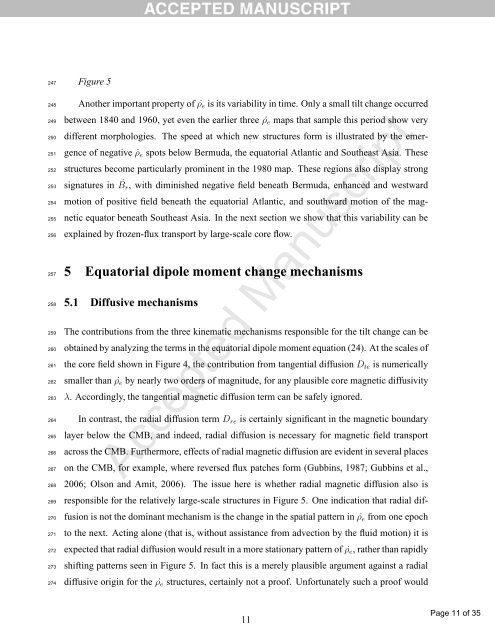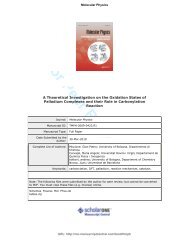Accepted Manuscript - TARA
Accepted Manuscript - TARA
Accepted Manuscript - TARA
You also want an ePaper? Increase the reach of your titles
YUMPU automatically turns print PDFs into web optimized ePapers that Google loves.
247<br />
Figure 5<br />
248<br />
249<br />
250<br />
251<br />
252<br />
253<br />
254<br />
255<br />
256<br />
257<br />
258<br />
259<br />
260<br />
261<br />
262<br />
263<br />
264<br />
265<br />
266<br />
267<br />
268<br />
269<br />
270<br />
271<br />
272<br />
273<br />
274<br />
Another important property of ρ˙<br />
e is its variability in time. Only a small tilt change occurred<br />
between 1840 and 1960, yet even the earlier three ρ˙<br />
e maps that sample this period show very<br />
different morphologies. The speed at which new structures form is illustrated by the emer-<br />
gence of negative ˙ρ e spots below Bermuda, the equatorial Atlantic and Southeast Asia. These<br />
structures become particularly prominent in the 1980 map. These regions also display strong<br />
signatures in B ˙ r , with diminished negative field beneath Bermuda, enhanced and westward<br />
motion of positive field beneath the equatorial Atlantic, and southward motion of the mag-<br />
netic equator beneath Southeast Asia. In the next section we show that this variability can be<br />
explained by frozen-flux transport by large-scale core flow.<br />
5 Equatorial dipole moment change mechanisms<br />
5.1 Diffusive mechanisms<br />
The contributions from the three kinematic mechanisms responsible for the tilt change can be<br />
obtained by analyzing the terms in the equatorial dipole moment equation (24). At the scales of<br />
the core field shown in Figure 4, the contribution from tangential diffusion D te is numerically<br />
smaller than ρ˙<br />
e by nearly two orders of magnitude, for any plausible core magnetic diffusivity<br />
λ. Accordingly, the tangential magnetic diffusion term can be safely ignored.<br />
In contrast, the radial diffusion term D re is certainly significant in the magnetic boundary<br />
layer below the CMB, and indeed, radial diffusion is necessary for magnetic field transport<br />
across the CMB. Furthermore, effects of radial magnetic diffusion are evident in several places<br />
<strong>Accepted</strong> <strong>Manuscript</strong><br />
on the CMB, for example, where reversed flux patches form (Gubbins, 1987; Gubbins et al.,<br />
2006; Olson and Amit, 2006). The issue here is whether radial magnetic diffusion also is<br />
responsible for the relatively large-scale structures in Figure 5. One indication that radial dif-<br />
fusion is not the dominant mechanism is the change in the spatial pattern in ρ˙<br />
e from one epoch<br />
to the next. Acting alone (that is, without assistance from advection by the fluid motion) it is<br />
expected that radial diffusion would result in a more stationary pattern of ρ˙<br />
e , rather than rapidly<br />
shifting patterns seen in Figure 5. In fact this is a merely plausible argument against a radial<br />
diffusive origin for the ρ˙<br />
e structures, certainly not a proof. Unfortunately such a proof would<br />
11<br />
Page 11 of 35
















